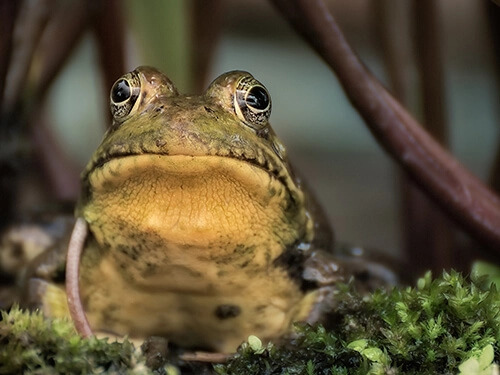Frog Symphony

About this Inquiry
This inquiry focuses on analyzing spatial and temporal data for frog calls to determine the best time of day and location to hear a symphony of frogs. Different frog species are more active at certain times of the year, at certain times of day, and in particular types of ecosystems. Data about many frog species are collected by FrogWatch, an amphibian-focused citizen science project. Students can triangulate multiple sources of FrogWatch data to make predictions. First, students will use a land cover map to determine the locations where frogs are most likely to be present, either in their local area or an area of their choice. Then, students will use data visualizations, such as histograms and calling calendars, to make decisions about which times of years frogs are most active in their chosen area. Finally, students will use data on the intensity of frog calls to determine which times of day frogs are most active. Using these data, students will make predictions about where and when they could hear a symphony of frog calls. This inquiry is designed for high school students.
Instructional Days
2 days
Learning Goals
- Use graphical displays (e.g., maps, charts, graphs, and/or tables) of large data sets to identify temporal and spatial relationships about where and when frogs are most active in a local area.
- Construct an explanation that includes qualitative or quantitative relationships between variables that predict(s) what time of year, day, and location one might hear a chorus of frog calls.

Type of Analysis
- Graphing – Histogram
- Graphing – Calling calendar
- Mapping – Spatial Analysis
About this Citizen Science Project:
FrogWatch is the Akron Zoo’s citizen science program and provides individuals, groups, and families opportunities to learn about wetlands in their communities by reporting on the calls of local frogs and toads. Citizen scientists are trained and then volunteer to listen for frogs and toads during evenings from February through August and submit these observations to the FieldScope FrogWatch project. The data are collected as an effort to monitor populations of amphibians, as many have experienced dramatic declines in recent decades.
FrogWatch has established a network of chapters across the United States, hosted at zoos and aquariums, nature centers, and similar organizations. Chapters are led by chapter coordinators–trained experts in the program–who mentor volunteers in their community and host training sessions to recruit new ones. FrogWatch-trained volunteers collect data using the same protocol in order to track similar variables, such as habitat, call, and time of day.